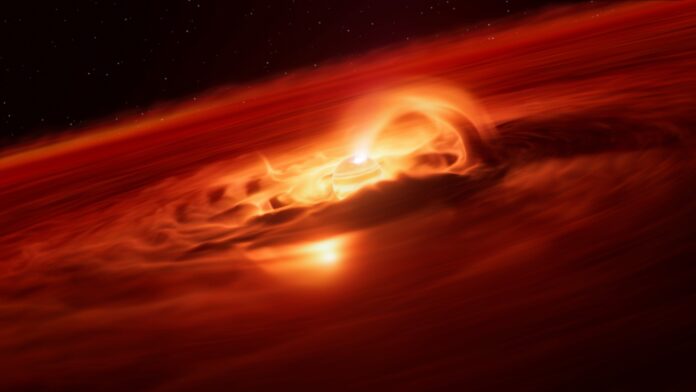
Key Developments
- Astronomers stunned as a rogue planet suddenly starts consuming 6 billion tons of gas and dust per second, blurring the line between stars and planets.
- “This is the strongest accretion episode ever recorded for a planetary-mass object,” researchers said after observing Cha 1107-7626.
- The discovery comes just as interstellar object 3I/ATLAS passes our galaxy, prompting fresh speculation about cosmic links.
By Samuel Lopez
USA HERALD – Astronomers have recorded a galactic event unlike anything previously seen: a rogue planet in the constellation Chamaeleon, roughly 620 light-years away, suddenly began devouring 6 billion tons of gas and dust per second.
The object, designated Cha 1107-7626, is five to ten times the mass of Jupiter and is still in its infancy—just one to two million years old. It was observed by the European Southern Observatory’s Very Large Telescope in Chile, supported by additional data from the James Webb Space Telescope.
“This is the strongest accretion episode ever recorded for a planetary-mass object,” lead study author Víctor Almendros-Abad said. Co-author Belinda Damian noted the growth “blurs the line between stars and planets,” since the devouring frenzy mirrors activity normally seen in stellar births.
Cha 1107-7626 is a so-called rogue planet—a planetary-mass body that drifts freely through the galaxy, untethered to any star. Astronomers estimate trillions of these exist, but most pass undetected, lost in perpetual night.
These strange objects intrigue astronomers because they are “neither a star nor a proper planet,” said Alexander Scholz, an astronomer at Scotland’s University of St. Andrews and co-author of the new study.
What makes this case remarkable is the speed and violence of its growth spurt. In August, the object’s accretion rate increased eight-fold, consuming matter at a pace never seen in planetary-mass observations. Researchers also detected water vapor in the surrounding disc during the event—another process typically linked to stellar formation, not planetary birth.
“This invites us to wonder what worlds beyond our own could be like during their nascent stages,” said Amelia Bayo, a co-author of the Astrophysical Journal Letters study.


